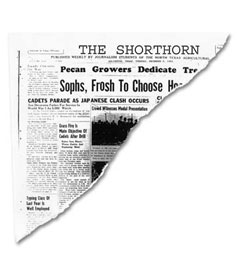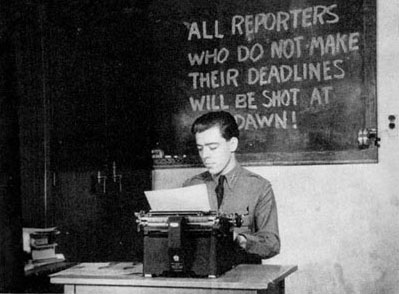| Q&A with UTA's oldest living graduate | Alumni as college presidents | Recognition of contributors |
 |
||
| Home Forethought Campus Buzz Feature Stories Re:Search The Score Alum News Yesteryear | ||
|
|
| Lloyd Clark oversaw what is believed to be the first makeover of a completed Shorthorn front page after the Japanese attacked Pearl Harbor in 1941. Clark, the newspaper's editor at the time, worked quickly to include campus reaction to the "momentous episode." |
As I hitched my saber onto my Sam Browne belt, preparing to join the military formation on the street in front of Davis Hall (now Brazos residence hall), a fellow cadet exclaimed: “Pearl Harbor has been bombed. I heard it on the radio!”
The date was Dec. 7, 1941. The North Texas Agricultural College (now UTA) cadet corps was to parade that Sunday, honoring a World War I veteran who was to be presented, belatedly, a Purple Heart for injuries received in 1918.
William S. Rosamond of Burleson had been wounded in the Chateau-Thierry sector of France. His son, cadet Capt. Paul H. Rosamond, was to pin the medal on his father’s lapel. Thirty-three months later, Army Lt. Paul H. Rosamond would be awarded a Purple Heart himself for wounds sustained while commanding an 81mm mortar platoon in—as fate determined—the Chateau-Thierry area.
In the reviewing stand for the parade was recently commissioned Army Lt. Forrest Ulm, sitting next to Associate Dean George L. Dickey. Ulm had been a cadet major in the corps during the 1939-41 school year. (Within three years, 1st Lt. Ulm would be buried on an island in the Southwest Pacific theater of the war.)
Those of us parading observed spectators collecting in two groups. As we came off the field, we learned that they were clustering around an individual with a portable radio and beside a parked car equipped with a radio. The news of the Japanese attack on Pearl Harbor in Hawaii was spreading.

As editor of The Shorthorn, I had made the p. 1 dummy Saturday and had written in advance the account of the parade and award as it was expected to be performed. But certainly an event of the magnitude of the Japanese attack should be noted in the edition to be published Tuesday. I called managing editor Violet Bean and asked her to get comments from individuals on campus first thing Monday morning.
A photo had been made at the beginning of the Sunday parade showing Lt. Ulm with Dean Dickey. It was sent to the engraver in Fort Worth via bus Sunday afternoon. The cut (wood-mounted engraving) was due back at the Arlington bus depot Monday afternoon.
I retyped the parade story, noting that while the cadet corps was honoring a World War I veteran, World War II was beginning.
When the editorial staff gathered at the printing plant Monday to “make up” the four pages, we were keenly aware that The Shorthorn was recording a momentous episode that likely would impact our lives in ways we never anticipated.
The photoengraving was picked up at the bus station, and we had page proofs ready for Professor Duncan Robinson to see around 6:30 p.m. Mr. Robinson was The Shorthorn faculty adviser and our journalism instructor.
Before we went home the night of Dec. 8, the Tuesday edition had been put to bed in the plant of The Arlington Journal on East Abram Street. Mr. Robinson took leave of us, saying, “Well done” on compiling a timely account of history in the making.
Despite the apprehension I felt in our country being at war, I believe I
slept soundly that night with the knowledge that The Shorthorn was one
of the first college weeklies to publish a story on World War II.
— Lloyd Clark (’42)
| Archives
| Alumni Association |
Giving to UTA | UTA
Home Copyright © 2005 UTA Magazine. All rights reserved. |
